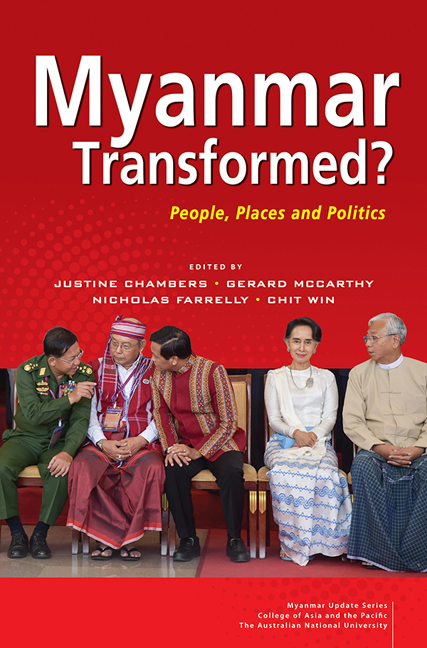Book contents
- Frontmatter
- Contents
- List of Tables
- List of Figuress
- Acknowledgements
- Contributors and Editors
- Part I Introduction
- Part II People
- Part III Places
- Part IV Politics
- 9 Partnership in Politics: The Tatmadaw and the NLD in Myanmar since 2016
- 10 From Ceasefire to Dialogue: The Problem of “All-Inclusiveness” in Myanmar's Stalled Peace Process
- 11 Securitization of the Rohingya in Myanmar
- 12 Forming an Inclusive National Identity in Myanmar: Voices of Mon People
- Part V Epilogue
- Abbreviations and Key Terms
- Index
12 - Forming an Inclusive National Identity in Myanmar: Voices of Mon People
from Part IV - Politics
Published online by Cambridge University Press: 12 February 2019
- Frontmatter
- Contents
- List of Tables
- List of Figuress
- Acknowledgements
- Contributors and Editors
- Part I Introduction
- Part II People
- Part III Places
- Part IV Politics
- 9 Partnership in Politics: The Tatmadaw and the NLD in Myanmar since 2016
- 10 From Ceasefire to Dialogue: The Problem of “All-Inclusiveness” in Myanmar's Stalled Peace Process
- 11 Securitization of the Rohingya in Myanmar
- 12 Forming an Inclusive National Identity in Myanmar: Voices of Mon People
- Part V Epilogue
- Abbreviations and Key Terms
- Index
Summary
In Myanmar, the failure to fulfil the needs and aspirations of the country's ethnic minorities in the wake of independence caused the outbreak of some of the world's longest-running civil wars. The process of democratization in plural societies is often fragile because different political actors who influence the transition may articulate potentially incompatible conceptualizations of national identity (Linz and Stepan 1996, p. 16). This can be particularly challenging when a majority group dominates the political landscape and attempts to impose its vision of the nation on other minority groups. This is the case in Myanmar where since independence ethnic people have aspired to the recognition of their cultural identities and the implementation of self-rule. This view has often clashed with the vision of the Tatmadaw, the military group that took power in 1962. Indeed, the Tatmadaw, which is predominantly comprised of members of the dominant “Bamar” ethnicity, imagines the country as a centralized state with a unified Bamar national identity, as opposed to the Bamar as one ethnic group among many.
The military government's resolve to strengthen the Burmanization or “Myanmafication” of culture and history as described by Gustaaf Houtman (1999, p.142–8) is a main cause of the gradual suppression of Myanmar's distinct cultural identities. The case of the Mon, one of Myanmar's main ethnic groups, illustrates this situation well. The 2017 decision of the NLDdominated parliament to rename a major bridge in Mon State after General Aung San despite strong local opposition is representative of the many ongoing challenges ethnic nationality groups still face (Htet Naing Zaw 2017). The renaming of this major infrastructure link after the “father of independence” was indeed strongly criticized for celebrating a Bamar hero rather than local identity. This controversy illustrates the incompatibility of ethnic aspirations with a particular notion of national identity promoted by the Bamar militarized elite, which is one of the reasons why civil war has been raging for more than half a century. In this light, building an inclusive national identity that respects the multinational character of Myanmar instead of presenting the nation as an expression of the Bamar alone would positively support peace.
- Type
- Chapter
- Information
- Myanmar Transformed?People, Places and Politics, pp. 277 - 308Publisher: ISEAS–Yusof Ishak InstitutePrint publication year: 2018

